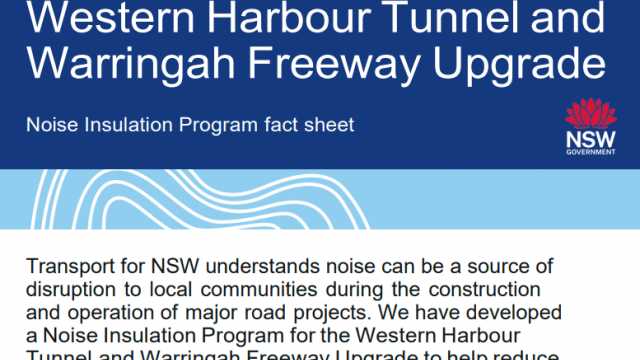Managing noise
Transport for NSW understands noise can be a source of disruption to local communities during the construction and operation of major road projects. This page provides more detail on how we will manage noise as part of the Warringah Freeway Upgrade.
Overview
The Western Harbour Tunnel and Warringah Freeway Upgrade project involves the creation of a third crossing of Sydney Harbour connecting to the M4-M5 Link at Rozelle and the Warringah Freeway at Cammeray, creating a western bypass of the CBD. Once complete, the project is predicted to reduce traffic noise for more than 60 per cent of properties near our surface roads.
There are generally two types of noise which may impact the community:
Construction noise - Temporary noise from construction activities while we build the project
Operational noise - Noise from road traffic once the project is complete
We understand noise is personal and is perceived differently from one person to the next. Noise is measured on a scale of units called decibels. We assess noise by averaging the quietest and loudest measurements while also considering how the human ear perceives it.
Construction noise
Residents who live near our work sites may hear noise during construction activities, such as when we are working on the road, delivering materials and removing spoil from tunnelling sites. Construction noise is temporary and often changes as work progresses.
To minimise the impact of noise on the local community, we use a range of mitigation measures to manage noise at the source. This includes temporary noise barriers around specific work areas, using less noisy equipment and staging our work to avoid extended periods of disruption.
We will be in contact with you throughout construction about how our work may impact you.
Operational noise
The project will improve noise levels for many properties but we acknowledge there will be some parts of the community who live near our permanent facilities and surface road upgrades who may notice some more noise as a result of an increase in traffic going in and out of the tunnels.
We always try to mitigate traffic noise at the source first through the road design process, including installing low noise pavement and noise barriers. We also consider the need for noise treatment at properties if our target noise levels can’t be achieved through at-source measures.
For further information on how we assessed noise and predicted impacts, read the below EIS chapters.
At-property noise treatment
We understand noise can be a source of disruption to local communities during the construction and operation of major road projects. To minimise the impact of our project on local residents, we are delivering at-property noise treatment to eligible properties. Noise treatment refers to architectural acoustic measures which aim to improve the sound resistance of properties, such as window and door upgrades.
We have developed a Noise Insulation Program which outlines the criteria and process for delivering noise treatment to affected properties as part of the project.
Providing at-property treatment is a complex process and involves a number of different steps. To learn more, see our fact sheet.
Contact Us
Noise insulation program
For all enquiries related to at property noise treatment or operational noise.
1800 312 772
Warringah Freeway Upgrade
For all construction related enquiries and noise complaints.
1800 931 189


